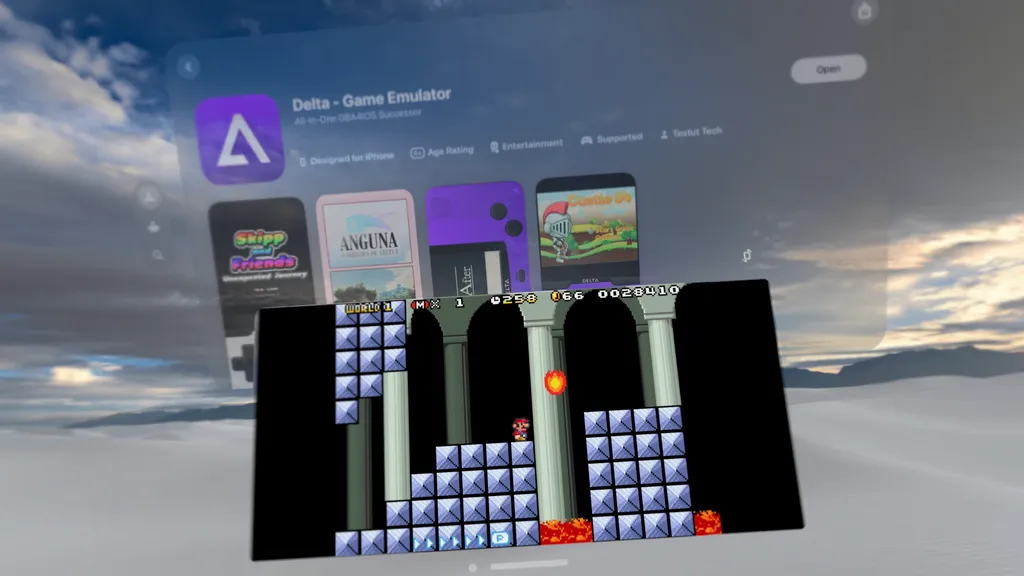A wave of emulators are starting to roll out across Apple platforms, Vision Pro included, as Joy-Cons and other official gamepads prove useful input accessories.
Before Apple even publicly signaled changes to its App Store policies inviting this type of software onto its storefront, a limited-run TestFlight started filling up on Vision Pro for a Game Boy Advance emulator. Today, the widely used Delta project launched across all current Apple devices with emulation for a wide range of Nintendo's decades-old gaming systems, Game Boy, DS, NES, SNES, and 64.
"Wherever possible, Nintendo and its licensees attempt to find ways to bring legitimate classics to current systems (via Virtual Console titles, for example)," Nintendo notes on its website FAQ.
Nintendo doesn't offer a path to that Virtual Console on any non-Nintendo hardware today. There's Xbox streaming, Steam streaming, and PlayStation streaming available in various incarnations on Apple, Meta, and Google app stores. Last year, Apple shared its Apple Vision Pro launch event with Disney as its premiere content partner. This year, Apple presents its next major debut of features and information in June at its WWDC event. Might Apple somehow surprise everyone and renew its partnership with Nintendo for a new age, including Vision Pro?
Aging gamers and retro fans have built an ever-growing suite of open source repositories and hardware tools to keep 20th-century's best video games alive. In some cases, fans also restore or extend original functionality. For example, despite the potential for piracy and misuse, rescuing Pokemon from a dying battery in a 30-year-old Game Boy cartridge enclosure is basically the same preservation process as backing up the game files themselves.
And when it comes to virtual reality, headsets like PSVR 2 or Vision Pro can use the high frame rates and true blacks of their OLED displays as a more flexible canvas upon which to represent the overall texture of classic gaming. In the case of Vision Pro specifically, the multitasking capabilities of the visionOS operating system may even start to feel like an actual analogy of classic gaming. What's to keep one of these new emulator apps from connecting to the Vision Pro Television app because the latter has a filter that really captures the feel of a 1990s cathode ray tube? And how is that any different to the user from running an RGB cable through your VCR to the TV in the 1990s?
One major difference is that players like myself are much older now while Nintendo and Apple have grown into massive multi-national organizations which employ governmental liaisons and vast legal apparatuses to protect their interests on a global scale. Nintendo's official site poses the question for us: "But can’t I make a backup copy if I own the video game?"
Nintendo's lawyers also answer it:
"You may be thinking of the backup/archival exception under the U.S. Copyright Act. There is some misinformation on the Internet regarding this backup/archival exception. This is a very narrow limitation that extends to computer software. Video games are comprised of numerous types of copyrighted works and should not be categorized as software only. Therefore, provisions that pertain to backup copies would not apply to copyrighted video game works and specifically ROM downloads, that are typically unauthorized and infringing."
Emulation’s Final Frontier?
That’s chilling language to suggest of people contributing to open source repositories so they can preserve for themselves, and the future, the very texture of their childhood.
There are multiple generations of people worldwide raised on Nintendo games who’ve encoded the timing of required button presses into their core memories. Meanwhile, Google demonstrated recently how to use AI trained on videos to make games from them. It is easy to see why Nintendo wants to protect its property to employ developers and make more games in this new age. But with emulation growing on headsets like Quest with CitraVR and Delta on visionOS, brands like Atari, Sega, and, yes, Nintendo, are going to have to keep pace with the children of the millennium they helped raise.
LAN parties recreated across phones and headsets? Split-screen multiplayer separated across VR and TV? Nostalgia-fueled officially licensed romps like Atari’s partnership with Pixel Ripped 1978?
Players are ready. Is Nintendo?




























